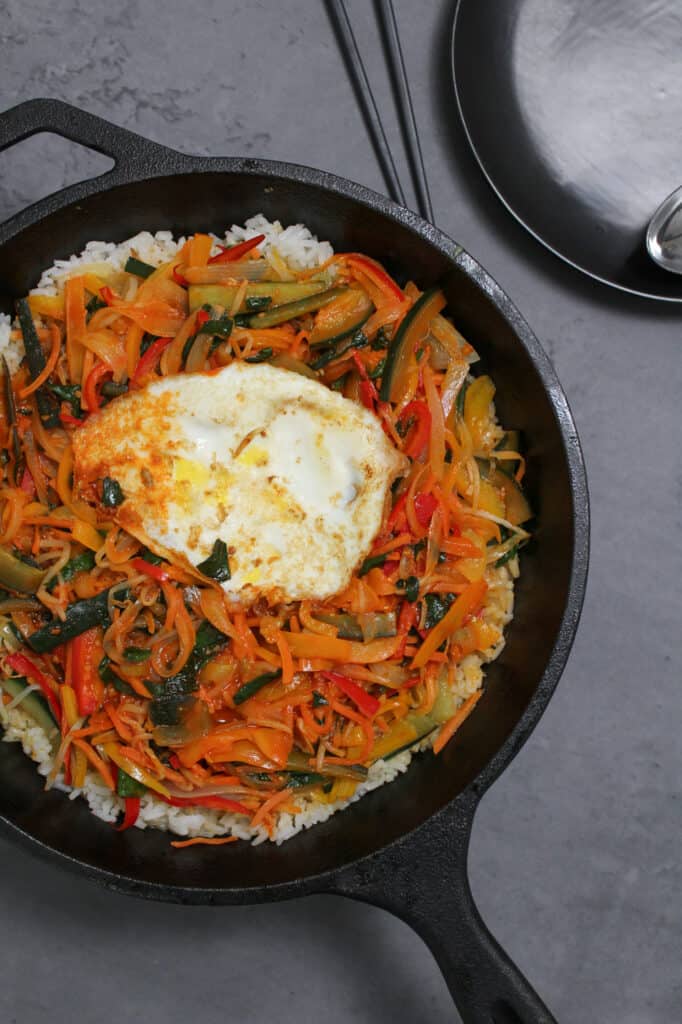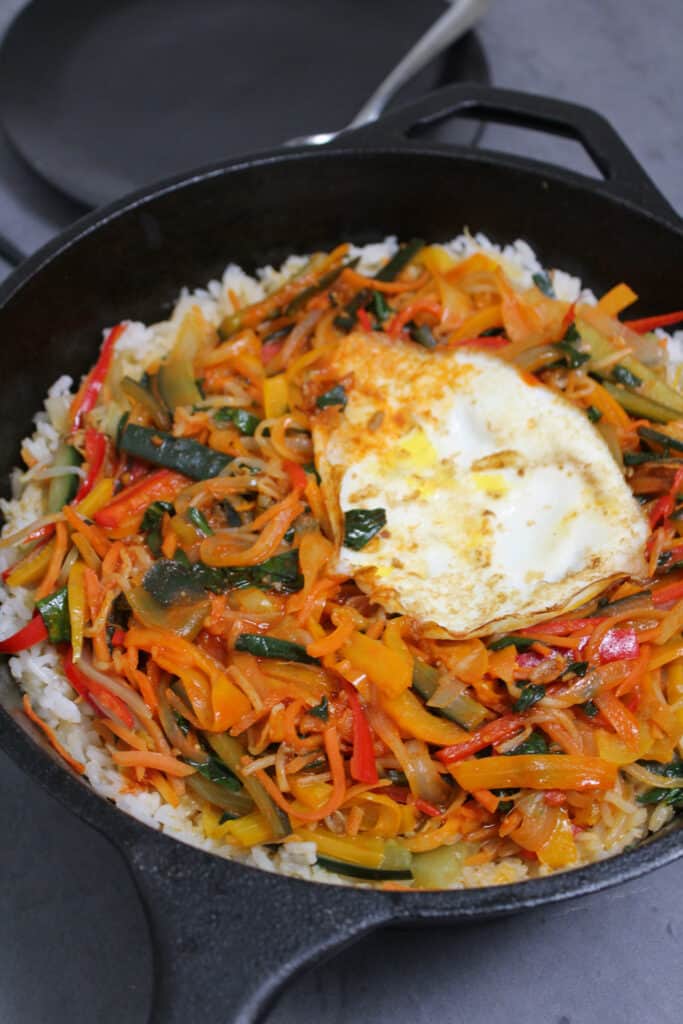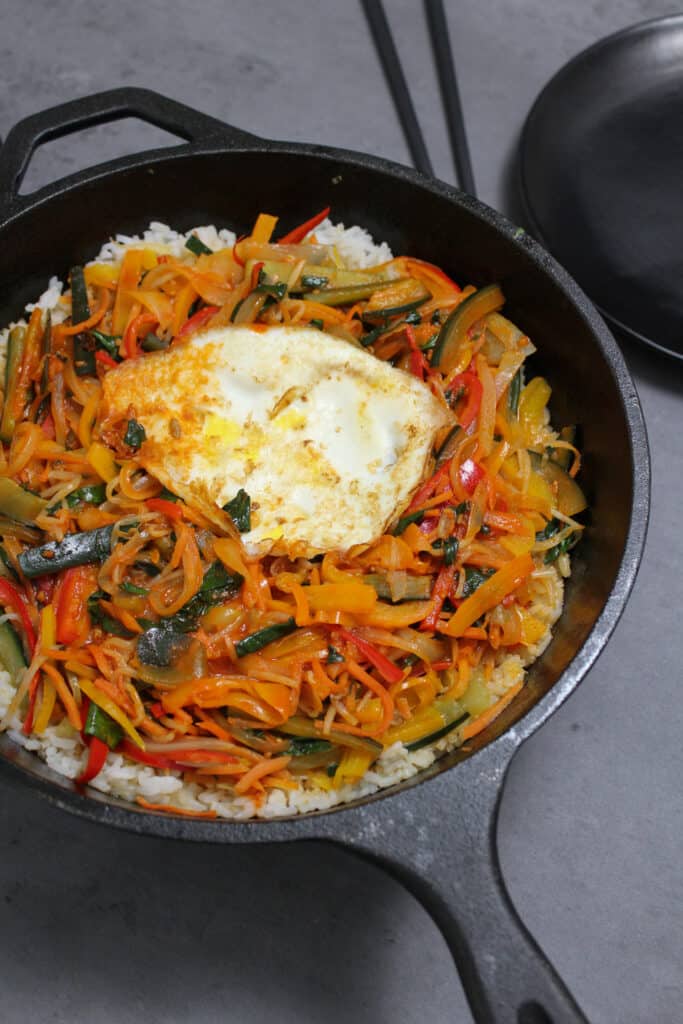Last updated: June 5th, 2024
This post may contain affiliate links. As Amazon Associates and through other affiliate programs, we earn from qualifying purchases if you click on a link – at no extra cost to you. We only promote products we actually use and truly love!
Make this easy vegetarian bibimbap in 35 minutes or less and serve it family-style for a quick and healthy dinner.

Asian dishes are one of our favorite kinds of cuisine to cook and eat, for two reasons. One, they tend to cook fairly quickly, so they’re great for busy nights. And two, they’re typically saucy, spicy, and super comforting, while also being fairly healthy (the best of both worlds!). Lots of Asian dishes are loaded with vegetables and flavorful sauces that make everything taste amazing. Including this easy vegetarian bibimbap recipe, our take on a traditional Korean dish inspired by the hot stone bibimbap we’ve tried at our favorite restaurants!
What Is Bibimbap?
Bibimbap is a Korean dish that literally translates to “mixed rice,” consisting of warm white rice topped with veggies, meat, egg, and often a spicy sauce made with gochujang. Our vegetarian version of bibimbap skips the meat, relying solely on the eggs for protein.
We also like to cook our bibimbap in a cast iron skillet to mimic the style of hot stone bibimbap, where the rice is added to a hot stone bowl coated with sesame oil so that it gets crispy. This is our preferred style of bibimbap, especially for dinner. The crispy, slightly sticky rice adds so much depth of flavor and texture to an already delicious dish!

Vegetarian Bibimbap Recipe Ingredients
Bibimbap bowls typically consist of rice, assorted vegetables with a mix of textures, a fried egg, and a sweet, savory, and spicy sauce. While you can absolutely customize the veggies in your bibimbap, here’s what goes in our bibimbap recipe:
- White rice, steamed
- Onion
- Chili peppers
- Bell pepper
- Carrots
- Cucumber
- Mung bean sprouts
- Spinach
- Sesame oil
- Soy sauce
- Egg
- Bibimbap sauce
You can find premade bibimbap sauce at some grocery stores – however, we recommend making it from scratch for the best flavor! It’s not difficult and only requires a few ingredients, including Korean gochujang paste (which is widely available at most stores). My Korean Kitchen has a great recipe (here) for classic gochujang bibimbap sauce that you should definitely try if you want to give scratch-made sauce a go.

How To Make Bibimbap At Home
To make a hot stone-inspired bibimbap at home, you’ll need to grab a deep cast iron pan, steam some white rice, chop your veggies, and prepare your bibimbap sauce (if making it from scratch). Here’s what to do next:
- Heat some vegetable oil in the cast iron pan over medium-high heat. Then add your tougher vegetables (onions, peppers, and carrots) and sauté until slightly softened, just a few minutes.
- Next, add your softer vegetables (cucumbers, bean sprouts) and sauté until softened, another few minutes.
- Finally, add any leafy veggies (like spinach) along with soy sauce and sesame oil. Sauté for just a minute or two until the spinach wilts. Then, transfer the contents of the pan to a bowl.
- Add more vegetable oil to the now-empty cast iron pan and return to medium heat. Add the steamed rice, pressing it into the bottom and sides of the pan to create a “bowl” for your veggies to sit in. Then, add the veggies back into the pan on top of the rice and let cook for 5 minutes or so to allow the rice to crisp.
- In the meantime, fry eggs in a separate pan to your liking.
- Finally, add bibimbap sauce to the veggies and gently stir to combine, without disturbing the rice. Top with fried eggs and serve immediately.
Bibimbap Serving Suggestions
Our bibimbap recipe is meant to be served family-style. Just bring the whole cast iron pan right to the dinner table with a few plates, spoons, and chopsticks! Bibibmbap is meant to be mixed, so you can dig right in and scoop out a serving of veggies and rice for yourself before mixing it all together and enjoying.
You can fry as many eggs as you want to serve fresh. You can even skip putting them on top of the bibimbap if you’d rather mix it in separately on each plate.

Storing & Reheating Leftovers
In case you don’t gobble everything up in one sitting, any leftover bibimbap can be stored in an air-tight container in the fridge for up to 3 days. Just make sure to avoid storing any cooked eggs with the rice and veggies, since they won’t keep or reheat as well.
Reheat leftover bibimbap in a frying pan or cast iron skillet over medium heat, or warm in the microwave for about 2 minutes.
Why You’ll Love This Recipe
This vegetarian bibimbap recipe is so quick and easy to prepare! You can cook it in about 35 minutes if you prep the veggies while the rice is steaming, since the dish moves fast once it’s in the cast iron pan. It’s also a super satisfying yet light dish that’s low in calories but packed with nutrients from all the veggies (yes, bibimbap is considered a healthy meal!).
Try our easy vegetarian bibimbap recipe for family dinner this week and enjoy the delicious combination of sweet, savory, and spicy flavors singing together on your palate. Don’t forget to rate, comment, and share if you love this recipe!
Love this recipe? You may enjoy these recipes, too:
- Spicy Udon Noodle Vegetable Stir Fry
- Teriyaki Chicken & Rice Bowl
- Garlic Noodles
- Pork Dumplings
- Black Bean & Rice Bake
To browse more of our latest recipes and seasonal dishes, visit our homepage here.
Like this recipe? Don’t forget to share it and follow us on Pinterest!

Easy Vegetarian Bibimbap
Equipment
- Cast iron skillet large
Ingredients
- 2 cups water
- 1 cup white rice dry
- 2 to 3 tablespoons vegetable oil
- 1 small yellow onion sliced
- 3 small Fresno chile peppers or other chili peppers, sliced thinly
- 1 medium orange bell pepper sliced thinly
- 1 cup shredded carrots
- 1 small cucumber sliced into thin strips
- 4.5 ounces mung bean sprouts soaked in water 5 minutes then drained
- 2.5 ounces baby spinach roughly chopped
- ½ teaspoon sesame oil
- 1 teaspoon low sodium soy sauce
- 2 to 4 large eggs
- ½ cup bibimbap sauce
Instructions
- First, steam the rice. Bring water to a boil in a small saucepan, then stir in rice, cover, and turn heat to low. Steam for about 20 minutes, or until the water has been absorbed and the rice is fluffy.
- Cook the veggies. Heat about 1 tbsp of the vegetable oil in a large cast iron pan over medium-high heat. Once it's hot, add onion, chili peppers, bell pepper, and carrots and sauté until slightly softened, about 2 to 3 minutes. Next, add the cucumber and mung bean sprouts. Sauté until soft, about 3 to 4 minutes. Then add spinach, sesame oil, and soy sauce and cook for another minute or two until the spinach is wilted. Finally, transfer the contents of the pan to a bowl and set aside.
- Next, crisp the rice. Add about 1 to 2 tbsp more vegetable oil to the cast iron pan and return to medium heat. Carefully swirl the oil around in the pan to evenly coat the bottom and sides. Then, add the steamed rice, pressing it into the bottom and sides of the pan to create a "bowl" shape for the veggies to sit in.
- Add the cooked veggies back into the pan, on top of the rice. Cook for about 5 minutes or so, to allow the rice enough time to crisp.
- In the meantime, fry eggs to your liking in a separate pan.
- Finally, add bibimbap sauce to the veggies and carefully stir to incorporate, without disturbing the rice. Top with fried eggs, then serve family-style.
Notes
Nutrition
If you have any questions regarding the information presented in this post, please refer to our Nutrition Disclaimer here.
Looking for kitchen inspiration? Head over to our shop to see what we cook with every day, plus recommendations for foodie gifts and eco-friendly products.
